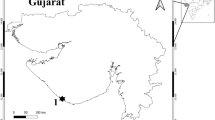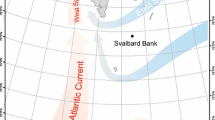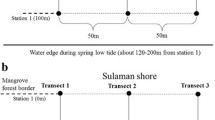Abstract
Mangrove gastropods and hermit crabs are frequently harvested for use as bait by artisanal trap and hook fishers, along the Kenyan coastline and elsewhere. In addition to mangrove degradation, the harvesting of shelled invertebrates, can alter shell availability and hence survival of these interdependent fauna. This study compares shell morphometric characteristics such as shell availability, adequacy and bait yield, among sites with different patterns of bait harvesting and other human disturbances. Shell morphometrics are also related to mangrove forest stand characteristics such as forest complexity, dominance, cutting intensity and sapling regeneration. Results indicate that the sampling regime, hermit crab taxa and mangrove zone influence morphometric characters of the gastropod and hermit crab. Significantly higher (P < 0.001) shell availability, adequacy and bait yield of the predominant hermit crab, Clibanarius danai, are recorded at upper and mid forested zones of sites with robust forest. This was attributed to shell selectivity of the crab, coupled with constancy of the environment at closed canopy sites. Apparently, forest structure is an important determinant of shell utilization patterns compared to prevailing bait harvesting activity. Protection of robust upper mangrove forest zones may therefore enhance sustainability of shelled bait harvesting and consequently the livelihoods support emanating from bait fishery.



Similar content being viewed by others
References
Absher MD, Peeke HVS, Chang ES, Snyder MJ (2001) Intraspecific competition and aggression for shells in the hermit crab Pagurus samuelis. Mar Freshw Behav Physiol 34(2):117–123
Barnes DKA (2001) Hermit crabs, human and Mozambique mangroves. Afr J Ecol 39:241–248
Barnes DKA (2003) Ecology of sub-tropical hermit crabs in SW Madagascar: short range migrations. Mar Biol 142:549–557
Botelho AZ, Costa AC (2000) Shell occupancy of the intertidal hermit crab Clibanarius erythopus (Decapoda; Diogenidae) on Sao Miguel (Azores). Hydrobiologia 440:111–117
Bouillon S, Koedam N, Ramay AV, Dehairs F (2002) Primary productivity sustains macroinvertebrate community in intertidal mangrove. Oecologia 130:441–448
Carlen A, Olafsson E (2002) The effect of the gastropod Terebralia palustris on infaunal community in a tropical tidal mudflat in East Africa. Wetl Ecol Manag 10:303–311
De Grave S, Barnes DKA (2001) Ecology of tropical hermit crabs (Crustacea: Decapoda) on Quirimba island, Mozambique: a multivariate assemblage perspective. Trop Zool 14(2):197–205
Duke NC (2001) Gap creation and regenerative processes driving diversity and structure of mangrove ecosystems. Wetl Ecol Manag 9:257–269
Elders of Atafu Atoll (2012) Echoes at fisherman’s rock: traditional Tokelau fishing. In: Hooper H, Tinielu I (eds) Knowledge of nature, vol 4. UNESCO, Paris
Fisheries Frame Survey (2012) Marine fisheries sector National Report. GOK, Ministry of Fisheries Development &Department of Fisheries
Fratini S, Cannicci S, Vannini M (2001) Competition and interaction between Neosarmatium smithi (Crustacea-Decapoda)and Terebralia palustris (Mollusca-Gastropod) in a Kenyan mangrove. Mar Biol 137:309–316
Griffiths CL, Branch Frssaf GM (1997) The exploitation of coastal invertebrates and seaweeds in South Africa: historical trends and evolutionary impact and implications for management. Trans R Soc S Afr 52(1):121–148
Guest MA, Connolly RM, Lee SY, Loneragan NR, Breitfuss MJ (2006) Mechanism for small-scale movement of carbon among estuarine habitats: organic matter transfer not crab movement. Oecologia 148:88–96
Hodgson AN, Allanson Frssaf BR, Cretchley R (2000) The exploitation of Upogebia africana (Crustacea: thalasinidae) for bait in Kynsna estuary. Trans R Soc S Afr 55(2):197–204
Hoorweg J, Wangila B, Degan A (2009) Artisanal fisheries on the Kenyan coast; household livelihood and Marine Resources Resource Management, Leiden
Kendrick GW, Morse K (1982) An aboriginal shell midden deposit from the Warroora coast, Northwestern Australia. Aust Archaeol 14:6–12
Kihia CM, Mathooko JM, Ruwa RK, Shivoga WA (2010) Mangrove litter biomass input in a forest impacted by human physical disturbance, Gazi Bay, Kenyan. Ecotropica 16:112–123
Kihia CM, Muthumbi A, Okondo J, Nthiga A, Njuguna VM (2014) Mangrove hermit crab utilization in artisanal bait fishery: narratives on bait collection, processing and use by bait fishers at Mida creek, Kenya. SANCOR Newslett
Krumme U, Saint-Paul U (2010) Dynamics in mangrove fish assemblages on a Macrotidal coast. In: Saint-Paul U, Schneider H (eds) Mangrove dynamics and management in North Brazil. Ecological studies 211, pp 189–209
Mazda Y, Wolanski E, Ridd PV (2007) The role of physical processes in mangrove environments. Manual for the preservation and utilization of mangrove ecosystems. TERRATAUB, Tokyo
Mcnae W, Kalk M (1962) The ecology of the mangrove swamp of Inhaca island, Mozambique. J Ecol 50(1):19–34
Nalin MDV, Somers MJ (2007) Shell availability and use by hermit crab Clibanarius verescens along the Eastern Cape coast, South Africa. Acta Zoologica Academiae Scientiarum Hungaricae 53(2):149–155
Ngo-Masson VM, Essome-KKoum GL, Ngollo-Dina E, Din N (2012) Comparison of macrobenthos of Wouri river estuary mangrove, Douala, Cameroon. Afr J Mar Sci 34(3):349–360
Oba T, Goshima S (2004) Temporal and spatial settlement pattern of sympatric hermit crabs and the influence of shell resources available. Mar Biol 44:871–879
Reese ES (1969) Behavioral adaptation of intertidal hermit crabs. Am Zool 9(2):343–355
Richmond MD (2011) A field guide to the seashores of Eastern Africa and the Western Indian Ocean Islands. 3rd ed, Sida/WIOMSA
Teoh HW, Hussain MAS, Chong VC (2014) Influence of habitat heterogeneity on the assemblages and shell use of hermit crabs (Anomura: Diogenidae). Zoological Stud 53(67):1–9
Tricarico E, Gherardi F (2006) Shell acquisition by hermit crab: which tactic is more efficient? Behav Ecol Sociobiol 60:492–500
Tuda A, Omar M (2012) Protection of marine areas in Kenya. George Wright Program 29(1):43–50
Turra A, Leite FPP (2004) Shell size selection by intertidal sympatric hermit crabs. Mar Biol 145:251–257
Versleyen N, Hoorweg J (2008) From farming to fishing: marine resource conservation a new generation of fishermen. West Indian Ocean J Mar Sci 7(1):1–14
Wait M (2010). Resource utilization and reproduction of the hermit crab Clibanarius virescen (Crustacea: Decapoda: Anomura) in South Africa. PhD thesis, Nelson Mandela Metropolitan University
Acknowledgments
The research grant for this study was provided by the National Council of Science and Technology, Kenya, awarded to A Muthumbi, CM Kihia and J Okondo. Institutional support and laboratory facilities provided by Nairobi and Egerton universities, Kenya Marine and Fisheries Institute are appreciated. Members of the Mida Creek Conservation Community, especially J. Mwamure, assisted in introduction to fishers. A Nthiga and V Njuguna (Msc Students University of Nairobi students) participated in both field and laboratory work. J. Ngatia, S. Muhamed and M. Abutrika (University of Nairobi Bsc students), participated in fieldwork. The contributions and suggestions made by the anonymous reviewers are also appreciated.
Author information
Authors and Affiliations
Corresponding author
Rights and permissions
About this article
Cite this article
Kihia, C.M., Muthumbi, A., Okondo, J. et al. Gastropods shell utilization among hermit crabs targeted by bait fishers along a tropical mangrove fringed creek, Mida, Kenya. Wetlands Ecol Manage 23, 921–932 (2015). https://doi.org/10.1007/s11273-015-9429-z
Received:
Accepted:
Published:
Issue Date:
DOI: https://doi.org/10.1007/s11273-015-9429-z




